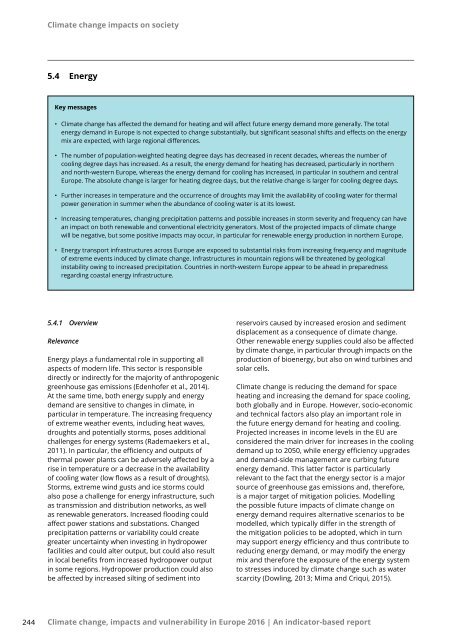Climate change impacts and vulnerability in Europe 2016
document
document
You also want an ePaper? Increase the reach of your titles
YUMPU automatically turns print PDFs into web optimized ePapers that Google loves.
<strong>Climate</strong> <strong>change</strong> <strong>impacts</strong> on society<br />
5.4 Energy<br />
Key messages<br />
• <strong>Climate</strong> <strong>change</strong> has affected the dem<strong>and</strong> for heat<strong>in</strong>g <strong>and</strong> will affect future energy dem<strong>and</strong> more generally. The total<br />
energy dem<strong>and</strong> <strong>in</strong> <strong>Europe</strong> is not expected to <strong>change</strong> substantially, but significant seasonal shifts <strong>and</strong> effects on the energy<br />
mix are expected, with large regional differences.<br />
• The number of population-weighted heat<strong>in</strong>g degree days has decreased <strong>in</strong> recent decades, whereas the number of<br />
cool<strong>in</strong>g degree days has <strong>in</strong>creased. As a result, the energy dem<strong>and</strong> for heat<strong>in</strong>g has decreased, particularly <strong>in</strong> northern<br />
<strong>and</strong> north-western <strong>Europe</strong>, whereas the energy dem<strong>and</strong> for cool<strong>in</strong>g has <strong>in</strong>creased, <strong>in</strong> particular <strong>in</strong> southern <strong>and</strong> central<br />
<strong>Europe</strong>. The absolute <strong>change</strong> is larger for heat<strong>in</strong>g degree days, but the relative <strong>change</strong> is larger for cool<strong>in</strong>g degree days.<br />
• Further <strong>in</strong>creases <strong>in</strong> temperature <strong>and</strong> the occurrence of droughts may limit the availability of cool<strong>in</strong>g water for thermal<br />
power generation <strong>in</strong> summer when the abundance of cool<strong>in</strong>g water is at its lowest.<br />
• Increas<strong>in</strong>g temperatures, chang<strong>in</strong>g precipitation patterns <strong>and</strong> possible <strong>in</strong>creases <strong>in</strong> storm severity <strong>and</strong> frequency can have<br />
an impact on both renewable <strong>and</strong> conventional electricity generators. Most of the projected <strong>impacts</strong> of climate <strong>change</strong><br />
will be negative, but some positive <strong>impacts</strong> may occur, <strong>in</strong> particular for renewable energy production <strong>in</strong> northern <strong>Europe</strong>.<br />
• Energy transport <strong>in</strong>frastructures across <strong>Europe</strong> are exposed to substantial risks from <strong>in</strong>creas<strong>in</strong>g frequency <strong>and</strong> magnitude<br />
of extreme events <strong>in</strong>duced by climate <strong>change</strong>. Infrastructures <strong>in</strong> mounta<strong>in</strong> regions will be threatened by geological<br />
<strong>in</strong>stability ow<strong>in</strong>g to <strong>in</strong>creased precipitation. Countries <strong>in</strong> north-western <strong>Europe</strong> appear to be ahead <strong>in</strong> preparedness<br />
regard<strong>in</strong>g coastal energy <strong>in</strong>frastructure.<br />
5.4.1 Overview<br />
Relevance<br />
Energy plays a fundamental role <strong>in</strong> support<strong>in</strong>g all<br />
aspects of modern life. This sector is responsible<br />
directly or <strong>in</strong>directly for the majority of anthropogenic<br />
greenhouse gas emissions (Edenhofer et al., 2014).<br />
At the same time, both energy supply <strong>and</strong> energy<br />
dem<strong>and</strong> are sensitive to <strong>change</strong>s <strong>in</strong> climate, <strong>in</strong><br />
particular <strong>in</strong> temperature. The <strong>in</strong>creas<strong>in</strong>g frequency<br />
of extreme weather events, <strong>in</strong>clud<strong>in</strong>g heat waves,<br />
droughts <strong>and</strong> potentially storms, poses additional<br />
challenges for energy systems (Rademaekers et al.,<br />
2011). In particular, the efficiency <strong>and</strong> outputs of<br />
thermal power plants can be adversely affected by a<br />
rise <strong>in</strong> temperature or a decrease <strong>in</strong> the availability<br />
of cool<strong>in</strong>g water (low flows as a result of droughts).<br />
Storms, extreme w<strong>in</strong>d gusts <strong>and</strong> ice storms could<br />
also pose a challenge for energy <strong>in</strong>frastructure, such<br />
as transmission <strong>and</strong> distribution networks, as well<br />
as renewable generators. Increased flood<strong>in</strong>g could<br />
affect power stations <strong>and</strong> substations. Changed<br />
precipitation patterns or variability could create<br />
greater uncerta<strong>in</strong>ty when <strong>in</strong>vest<strong>in</strong>g <strong>in</strong> hydropower<br />
facilities <strong>and</strong> could alter output, but could also result<br />
<strong>in</strong> local benefits from <strong>in</strong>creased hydropower output<br />
<strong>in</strong> some regions. Hydropower production could also<br />
be affected by <strong>in</strong>creased silt<strong>in</strong>g of sediment <strong>in</strong>to<br />
reservoirs caused by <strong>in</strong>creased erosion <strong>and</strong> sediment<br />
displacement as a consequence of climate <strong>change</strong>.<br />
Other renewable energy supplies could also be affected<br />
by climate <strong>change</strong>, <strong>in</strong> particular through <strong>impacts</strong> on the<br />
production of bioenergy, but also on w<strong>in</strong>d turb<strong>in</strong>es <strong>and</strong><br />
solar cells.<br />
<strong>Climate</strong> <strong>change</strong> is reduc<strong>in</strong>g the dem<strong>and</strong> for space<br />
heat<strong>in</strong>g <strong>and</strong> <strong>in</strong>creas<strong>in</strong>g the dem<strong>and</strong> for space cool<strong>in</strong>g,<br />
both globally <strong>and</strong> <strong>in</strong> <strong>Europe</strong>. However, socio-economic<br />
<strong>and</strong> technical factors also play an important role <strong>in</strong><br />
the future energy dem<strong>and</strong> for heat<strong>in</strong>g <strong>and</strong> cool<strong>in</strong>g.<br />
Projected <strong>in</strong>creases <strong>in</strong> <strong>in</strong>come levels <strong>in</strong> the EU are<br />
considered the ma<strong>in</strong> driver for <strong>in</strong>creases <strong>in</strong> the cool<strong>in</strong>g<br />
dem<strong>and</strong> up to 2050, while energy efficiency upgrades<br />
<strong>and</strong> dem<strong>and</strong>-side management are curb<strong>in</strong>g future<br />
energy dem<strong>and</strong>. This latter factor is particularly<br />
relevant to the fact that the energy sector is a major<br />
source of greenhouse gas emissions <strong>and</strong>, therefore,<br />
is a major target of mitigation policies. Modell<strong>in</strong>g<br />
the possible future <strong>impacts</strong> of climate <strong>change</strong> on<br />
energy dem<strong>and</strong> requires alternative scenarios to be<br />
modelled, which typically differ <strong>in</strong> the strength of<br />
the mitigation policies to be adopted, which <strong>in</strong> turn<br />
may support energy efficiency <strong>and</strong> thus contribute to<br />
reduc<strong>in</strong>g energy dem<strong>and</strong>, or may modify the energy<br />
mix <strong>and</strong> therefore the exposure of the energy system<br />
to stresses <strong>in</strong>duced by climate <strong>change</strong> such as water<br />
scarcity (Dowl<strong>in</strong>g, 2013; Mima <strong>and</strong> Criqui, 2015).<br />
244 <strong>Climate</strong> <strong>change</strong>, <strong>impacts</strong> <strong>and</strong> <strong>vulnerability</strong> <strong>in</strong> <strong>Europe</strong> <strong>2016</strong> | An <strong>in</strong>dicator-based report


